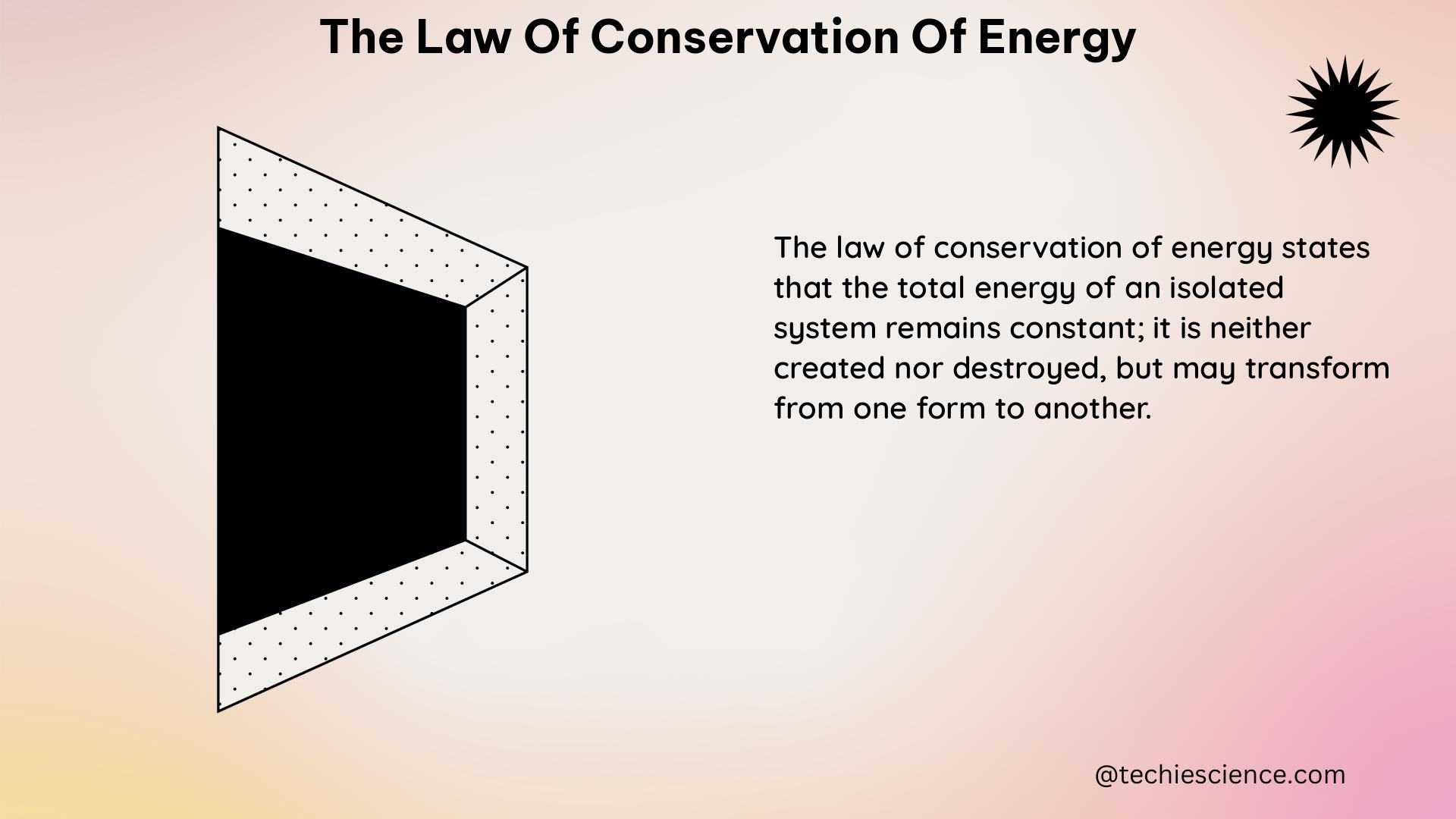The law of conservation of energy is a fundamental principle in physics that states that the total energy of an isolated system remains constant over time. This means that energy cannot be created or destroyed, only converted from one form to another. This comprehensive guide will delve into the theoretical explanations, mathematical formulations, and practical applications of this essential law, providing a valuable resource for physics students.
Theoretical Explanation
Mathematical Formulation
The law of conservation of energy can be mathematically expressed as:
$\Delta E = Q – W$
Where:
– $\Delta E$ is the change in energy of the system.
– $Q$ is the heat added to the system.
– $W$ is the work done on the system.
This equation represents the fundamental relationship between the change in energy, the heat added, and the work done on a system. It is a powerful tool for analyzing and understanding the behavior of various physical systems.
Kinetic Energy
The kinetic energy of an object is given by the formula:
$E_K = \frac{1}{2}mv^2$
Where:
– $m$ is the mass of the object.
– $v$ is the velocity of the object.
This formula demonstrates how the kinetic energy of an object is directly proportional to its mass and the square of its velocity. Understanding the relationship between kinetic energy and these physical quantities is crucial for analyzing the energy transformations in various systems.
Potential Energy
The potential energy of an object is given by the formula:
$E_P = mgh$
Where:
– $m$ is the mass of the object.
– $g$ is the acceleration due to gravity (approximately 9.8 m/s² on Earth).
– $h$ is the height of the object above the ground.
This formula shows how the potential energy of an object is directly proportional to its mass, the acceleration due to gravity, and the height of the object above the ground. Analyzing the potential energy of an object is essential for understanding the energy transformations in systems involving gravitational fields.
Examples and Data

Pendulum Experiment
In a pendulum experiment, the total energy remains constant. For example, if a pendulum has a mass of 1 kg and a height of 2 meters, its potential energy can be calculated as:
$E_P = mgh = 1 \text{ kg} \times 9.8 \text{ m/s²} \times 2 \text{ m} = 19.6 \text{ J}$
As the pendulum swings, this potential energy is converted to kinetic energy and back to potential energy, but the total energy remains constant. This demonstrates the principle of energy conservation in a simple, yet illustrative, system.
Levers and Pulleys
In a lever and pulley system, the force is multiplied but not the energy. For instance, if a force of 10 N is applied to a lever and the load moves 1 meter, the work done can be calculated as:
$W = F \times d = 10 \text{ N} \times 1 \text{ m} = 10 \text{ J}$
This work done is converted to potential energy, which can be calculated using the formula above. This example highlights how the law of conservation of energy applies to mechanical systems involving levers and pulleys.
Quantum Mechanics
In quantum mechanics, the energy of a system is described by the Hamiltonian operator. The expectation value of energy is time-independent if the Hamiltonian is time-independent. This ensures local energy conservation in quantum systems. The Hamiltonian operator, $\hat{H}$, is a mathematical representation of the total energy of a quantum system, and its eigenvalues correspond to the allowed energy levels of the system.
Historical Development
Early Contributions
The development of the law of conservation of energy can be traced back to the 19th century, with the contributions of several key figures:
- Julius Mayer: Mayer proposed the concept of the conservation of energy in 1842, based on his observations of the relationship between heat and work.
- Hermann von Helmholtz: Helmholtz formulated the principle of the conservation of energy in 1847, building upon the work of Mayer and others.
- James Joule: Joule conducted experiments that demonstrated the equivalence between heat and work, providing experimental evidence for the law of conservation of energy.
These early pioneers laid the foundation for the modern understanding of the law of conservation of energy and its role in the development of thermodynamics.
Noether’s Theorem
In 1915, Emmy Noether’s theorem provided a mathematical framework for understanding the conservation of energy as a consequence of time invariance in physical theories. Noether’s theorem states that for every continuous symmetry in a physical system, there is a corresponding conservation law. In the case of time invariance, the corresponding conservation law is the conservation of energy.
Noether’s theorem is a powerful tool in theoretical physics, as it connects the fundamental symmetries of nature with the conservation laws that govern the behavior of physical systems.
References
- The Law of Conservation of Energy
- Collections: The Law of Conservation of Energy
- The Law of Conservation of Energy
- Conservation of energy
- The Law of Conservation of Energy

The lambdageeks.com Core SME Team is a group of experienced subject matter experts from diverse scientific and technical fields including Physics, Chemistry, Technology,Electronics & Electrical Engineering, Automotive, Mechanical Engineering. Our team collaborates to create high-quality, well-researched articles on a wide range of science and technology topics for the lambdageeks.com website.
All Our Senior SME are having more than 7 Years of experience in the respective fields . They are either Working Industry Professionals or assocaited With different Universities. Refer Our Authors Page to get to know About our Core SMEs.